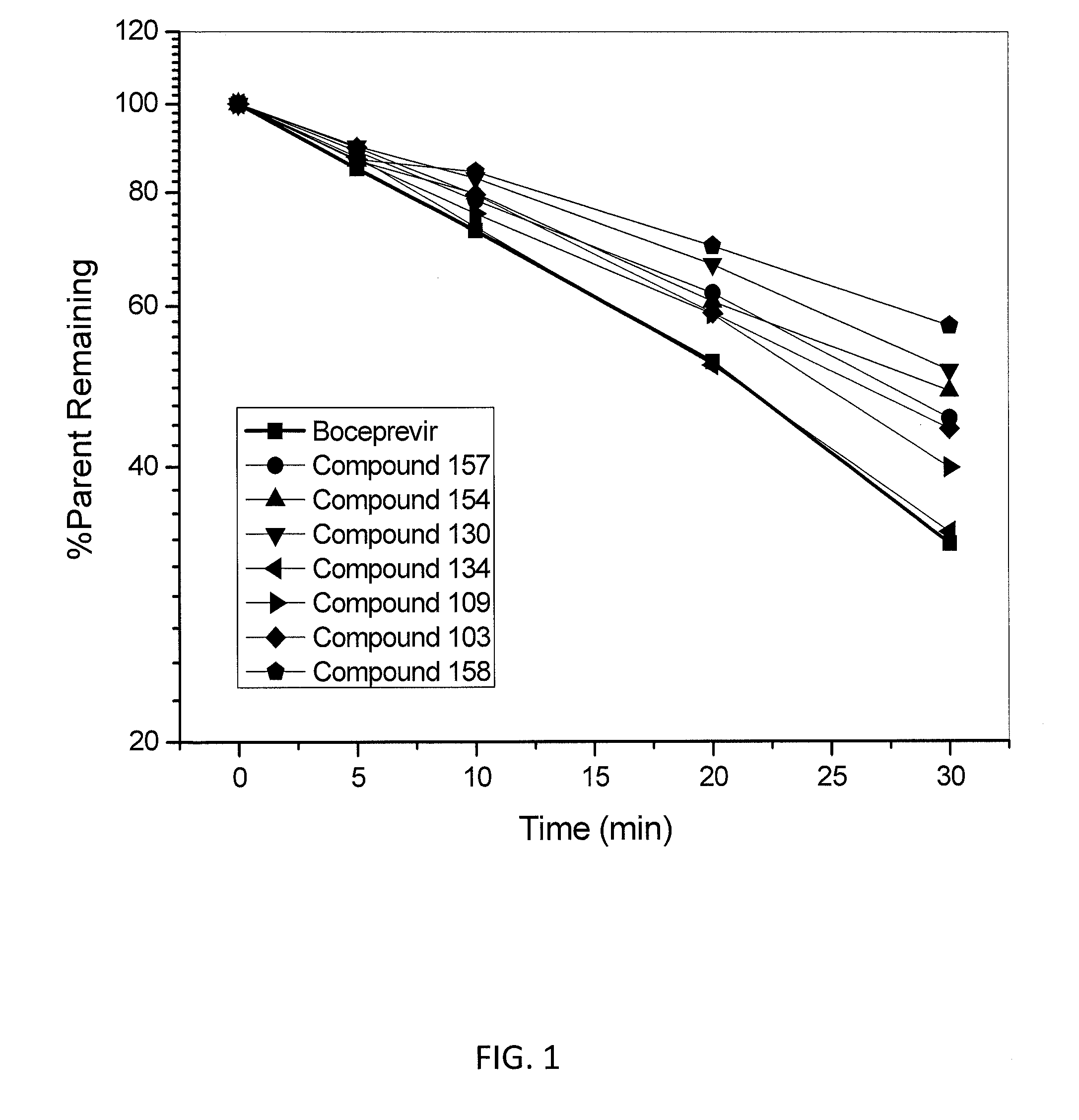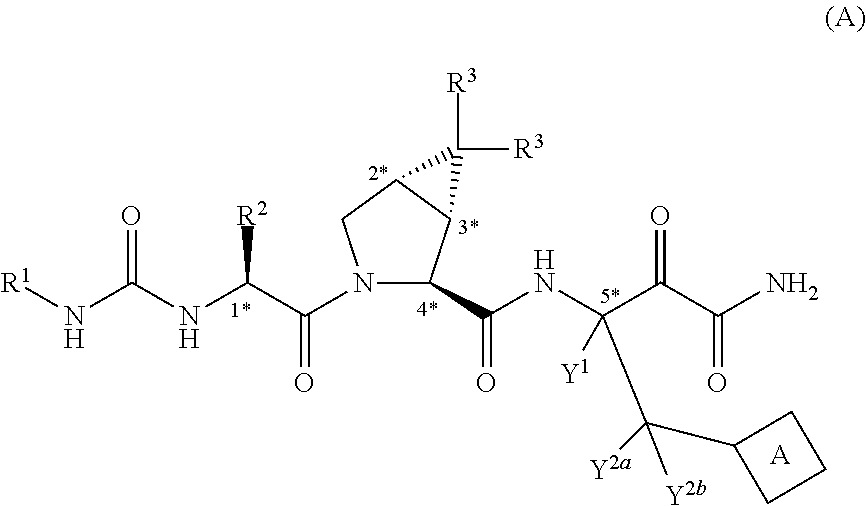Peptides for the Treatment of HCV Infections
a technology of peptides and hcv, which is applied in the direction of peptides/protein ingredients, drug compositions, peptides, etc., can solve the problems of poor absorption, distribution, metabolism and/or excretion (adme) properties, poor adme properties, and many current medicines
- Summary
- Abstract
- Description
- Claims
- Application Information
AI Technical Summary
Benefits of technology
Problems solved by technology
Method used
Image
Examples
example 1
Synthesis of 3-Amino-4-(cyclobutyl-d7)-4,4-d2-2-oxobutanamide hydrochloride (82)
[0135]
Step 1. 2,2,3,3,4,4-d6-Cyclobutane-1,1-dicarboxylic acid (68)
[0136]To a stirred solution of 67 (3.54 mL, 33.7 mmol, 99 atom % D, CDN Isotopes) and diethylmalonate (4.87 mL, 32.1 mmol) in ethanol (35 mL) at 60-65° C., was added dropwise a 21 wt % solution of sodium ethoxide in ethanol (24.1 mL, 64.2 mmol). Upon completion of the addition the reaction was cooled to approximately 50° C. and was subsequently stirred at 100° C. until an aliquot added to water was neutral to pH paper. The reaction was then cooled to room temperature, diluted with water and concentrated in vacuo to remove ethanol. The resulting aqueous solution was extracted with EtOAc (3×100 mL), the combined organics dried (Na2SO4), filtered and concentrated in vacuo. The resulting residue was purified by column chromatography (SiO2, 0-20% EtOAc / heptane) to afford the diethyl ester derivative of 68 (4.00 g, 60% yield). 1H NMR (CDCl3, 40...
example 2
Synthesis of (1R,2S,5S)—N-(4-Amino-1-(cyclobutyl-d7)-1,1-d2-3,4-dioxobutan-2-yl)-3-((S)-2-(3-tert-butylureido)-3,3-dimethylbutanoyl)-6,6-dimethyl-3-azabicyclo[3.1.0]hexane-2-carboxamide (Compound 154).
[0150]
(1R,2S,5S)—N-(4-Amino-1-(cyclobutyl-d7)-1,1-d2-3,4-dioxobutan-2-yl)-3-((S)-2-(3-tert-butylureido)-3,3-dimethylbutanoyl)-6,6-dimethyl-3-azabicyclo[3.1.0]hexane-2-carboxamide (Compound 154)
[0151]To a solution of carboxylic acid 83 (59.0 mg, 0.160 mmol, see J. Med. Chem., 2006, 49: 6074-6086 for preparation) and amine hydrochloride 82 (45.0 mg, 0.209 mmol, see Example 1) in acetonitrile (1.5 mL) at 0° C. was added EDC (46.0 mg, 0.240 mmol), HOBt (6.00 mg, 0.0480 mmol) and N-methyl morpholine (19.0 μL, 0.176 mmol). The reaction mixture was stirred at room temperature for 15 hours, concentrated in vacuo, diluted with 1M HCl, and extracted with EtOAc (3×20 mL). The combined organic layers were washed with 1M HCl, saturated NaHCO3 and brine, dried (MgSO4), filtered and concentrated in v...
example 3
Synthesis of (1R,2S,5S)—N-(4-Amino-1-(cyclobutyl-d7)-1,1-d2-3,4-dioxobutan-2-yl)-3-((S)-2-(3-(tert-butyl-d9)ureido)-3,3-di(methyl-d3)-4,4,4-d3-butanoyl)-6,6-di(methyl-d3)-3-azabicyclo[3.1.0]hexane-2-carboxamide (Compound 158).
[0152]
Part a. Synthesis of (S)-2-(Tert-butoxycarbonylamino)-3,3-di(methyl-d3)-4,4,4-d3-butanoic acid (56)
[0153]
Step 1. Pivalaldehyde-d9 (51)
[0154]In a 3-L 4-necked round bottom flask fitted with mechanical stirrer, reflux condenser, dropping funnel and thermometer were placed a few small crystals of iodine and then magnesium turnings (24.7 g, 1.03 mol). The bottom of the flask was heated with a heat gun until the iodine commenced to vaporize. The flask was allowed to cool while a solution of t-butyl chloride-d9 50 (100.0 g, 1.03 mol, Cambridge Isotopes, 98% isotopic purity) in anhydrous ether was placed in the dropping funnel. A portion of the solution of 50 in ether (3-5 mL) was added directly to the dry magnesium. More anhydrous ether (1 L) and a few small cr...
PUM
| Property | Measurement | Unit |
|---|---|---|
| temperature | aaaaa | aaaaa |
| time | aaaaa | aaaaa |
| temperature | aaaaa | aaaaa |
Abstract
Description
Claims
Application Information
 Login to View More
Login to View More - R&D
- Intellectual Property
- Life Sciences
- Materials
- Tech Scout
- Unparalleled Data Quality
- Higher Quality Content
- 60% Fewer Hallucinations
Browse by: Latest US Patents, China's latest patents, Technical Efficacy Thesaurus, Application Domain, Technology Topic, Popular Technical Reports.
© 2025 PatSnap. All rights reserved.Legal|Privacy policy|Modern Slavery Act Transparency Statement|Sitemap|About US| Contact US: help@patsnap.com



